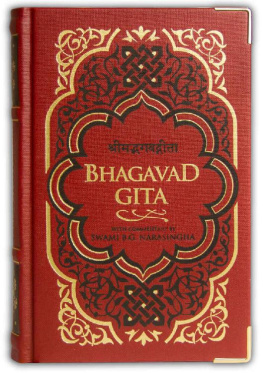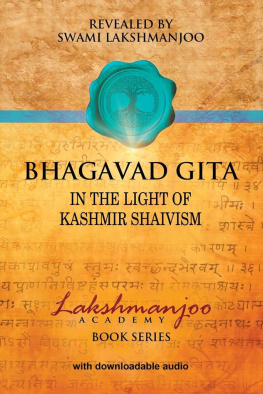Swami Nikhilananda - The Bhagavad Gita: Song of the Lord
Here you can read online Swami Nikhilananda - The Bhagavad Gita: Song of the Lord full text of the book (entire story) in english for free. Download pdf and epub, get meaning, cover and reviews about this ebook. year: 1944, publisher: INgrooves, genre: Religion. Description of the work, (preface) as well as reviews are available. Best literature library LitArk.com created for fans of good reading and offers a wide selection of genres:
Romance novel
Science fiction
Adventure
Detective
Science
History
Home and family
Prose
Art
Politics
Computer
Non-fiction
Religion
Business
Children
Humor
Choose a favorite category and find really read worthwhile books. Enjoy immersion in the world of imagination, feel the emotions of the characters or learn something new for yourself, make an fascinating discovery.
- Book:The Bhagavad Gita: Song of the Lord
- Author:
- Publisher:INgrooves
- Genre:
- Year:1944
- Rating:5 / 5
- Favourites:Add to favourites
- Your mark:
- 100
- 1
- 2
- 3
- 4
- 5
The Bhagavad Gita: Song of the Lord: summary, description and annotation
We offer to read an annotation, description, summary or preface (depends on what the author of the book "The Bhagavad Gita: Song of the Lord" wrote himself). If you haven't found the necessary information about the book — write in the comments, we will try to find it.
The Bhagavad Gita: Song of the Lord — read online for free the complete book (whole text) full work
Below is the text of the book, divided by pages. System saving the place of the last page read, allows you to conveniently read the book "The Bhagavad Gita: Song of the Lord" online for free, without having to search again every time where you left off. Put a bookmark, and you can go to the page where you finished reading at any time.
Font size:
Interval:
Bookmark:
The
BHAGAVAD GITA
Translated from the Sanskrit, with
Notes, Comments, and
Introduction
by
SWAMI NIKHILANANDA

NEW YORK
RAMAKRISHNAVIVEKANANDA CENTER
THE BHAGAVAD GITA
Copyright, 1944, by Swami Nikhilananda
PRINTED IN THE
UNITED STATES OF AMERICA
All rights in this book are reserved.
No part of the book may be reproduced in any manner whatsoever without written permission except in the case of brief quotations embodied in critical articles and reviews. For information address Ramakrishna Vivekananda Center, 17 East 94th Street, New York, N. Y. 10128.
Eighth Printing, 2004
ISBN 9780911206-28-9
Library of Congress Catalogue
Card Number 4433674.
FOREWORD
No translation of Plato is definitive; no translation of the Tao Teh King; no translation of the Bhagavad Gt. The more searching and impressive a work, the more it is impossible to convey, in any one version in another tongue, its full meaning. For that reason, the great classics of meditation require ever new translations, and each one adds a facet to the total sense. A new translation is always sufficiently formidable a task to deter anyone lacking in devotion, especially if he is familiar with the labors of his predecessors. A new translation of a great work, by a competent scholar, is therefore to be received with gratitude. It is especially to be welcomed if he has avoided, as I think Swami Nikhilananda has avoided, the warping of new translations by old: where a previous translator has hit upon a happy expression, a later translator is often constrained to avoid that expression, to seek the different solely for the sake of differing. The translation here given seems to me to be natural and direct, conveying the sense in admirably idiomatic English. At the same time, there has been no hesitation about using a few Sanskrit terms, such as dharma, yoga, my, essentially untranslatable, whose meaning the reader readily acquires.
No one who desires to grasp the spirit of religious aspiration of India can afford to remain unacquainted with this, The Lords Song. It is, in a sense, the New Testament of Hinduism. It had an important message to a people whose religious ideal tended to be contemplative and mystical, who had the genius to reveal to the world that ultimate goal for thought and reverence sometimes called The Absolute, the One without a second. Its message was the meaning of action, the justification even of warfare in the light of union with the Ultimate.
It is therefore the direct answer to those who identify the Indian spirit with that sort of mysticism which involves retreat from the world of affairs. Its position, as that one of the worlds classics most intimately known by so many millions, is assurance that its temper is indicative of the inner quality of modern India.
This fact lends a special interest to the commentary which accompanies the text. It is an adaptation from the extended commentary of ankarchrya, the greatest exponent of the Vednta system of philosophy in its strictly monistic form. There can be no doubt about the profundity of ankaras work, its great philosophical importance, and its permanent message to a world tempted to the distractions of pluralism. In my personal judgment, ankara missed the peculiar message of the Bhagavad Gt above referred to: his comments attempt to bring the Gt back to the supremacy of meditation over action as the condition of union with God. (p. 102) To scholars, this tug between differing points of view will add a spice of historical piquancy to the work. To the average reader, the effect of the difference may be confusing. Many of these comments, moreover, directed as they are to an India of the ninth century of our era, may appear either unnecessary or unenlightening to the man of today. If so, let him consider that the service to American scholarship in presenting ankaras view of the Gt in such close relation to the text will surely justify a hurdle so easily taken.
May this majestic poem find its way into the familiar literary friendship of many readers, and contribute to the sense of spiritual kinship with the most gifted people of Asia, akin to us both in blood and in language.
William Ernest Hocking
PREFACE
The aim of this new translation of the Bhagavad Gt is to present the book to the English-speaking public of the Western world as a manual of Hindu religion and philosophy. To achieve that purpose, notes and explanations have been added to the text, and the connexion of thought between the verses has been shown, wherever that seemed necessary. The explanations follow, in the main, the commentary on the Gt by ankarchrya. Abstruse and technical portions of the commentary have been omitted as of no particular interest to most readers of the book.
There has also been included the story of the Mahbhrata, which will acquaint the student of the Gt with its background and with the character of Sri Krishna. The bewilderment many students feel at the choice of a battle-field for the unfolding of a scheme of the Highest Good and liberation will, it is hoped, be removed by a perusal of the story.
In the Introduction the translator has made an attempt to explain some of the philosophical concepts of the Gt, such as the meaning of duty, its place in the moulding of the spiritual life, and the meaning of action and actionlessness from the relative and the absolute standpoint.
The diacritical table will help Occidental students in the pronunciation of unfamiliar Sanskrit words. The glossary will enable them to understand the meaning of Sanskrit expressions left in the text and notes for want of equivalents in English. It is hoped that they will simplify the problems faced by Westerners in studying the Bhagavad Gt.
There are in existence many English translations of the Bhagavad Gt. The present translator has profitably consulted two of these, one by D. S. Sarma and the other by A. Mahadeva Sastri. In addition, he has looked into Essays on the Gita by Sri Aurobindo. The works of Margaret E. Noble (Sister Nivedita) and Dr. Ananda Coomaraswamy have proved useful in the writing of the story of the Mahbhrata. He has also received invaluable help from Mr. Denver Lindley and Mr. Joseph Campbell, who revised the manuscript. It is a real pleasure to acknowledge the translators indebtedness to them all.
Humanity is now passing through a critical stage of transition. Many branches of physical science, psychology, sociology, and humanism are placing every day at our disposal a wealth of facts of which hitherto we have been unaware. They need collation and synthesis in order to be useful to the life of the individual and society. There is also the primal antithesis between this world and the other world, between secular duties and spiritual values. Men are confused and picture life as full of shreds and patches. But they feel a profound need of seeing life as a seamless garment. To those who sincerely seek, the Bhagavad Gt may be a means of coordinating these apparently contradictory facts.
Nikhilananda
New York
November 1, 1943
CONTENTS
_______________________________
In the original every chapter of the Bhagavad Gt is called a yoga, or way of union with God.
NOTE ON THE
PRONUNCIATION
OF SANSKRIT WORDS
a has the sound of o in come.
has the sound of a in far.
e has the sound of e in bed.
has the sound of ee in feel.
o has the sound of o in note.
u has the sound of u in full.
ai, ay has the sound of oy in boy.
au has the sound of
Next pageFont size:
Interval:
Bookmark:
Similar books «The Bhagavad Gita: Song of the Lord»
Look at similar books to The Bhagavad Gita: Song of the Lord. We have selected literature similar in name and meaning in the hope of providing readers with more options to find new, interesting, not yet read works.
Discussion, reviews of the book The Bhagavad Gita: Song of the Lord and just readers' own opinions. Leave your comments, write what you think about the work, its meaning or the main characters. Specify what exactly you liked and what you didn't like, and why you think so.















